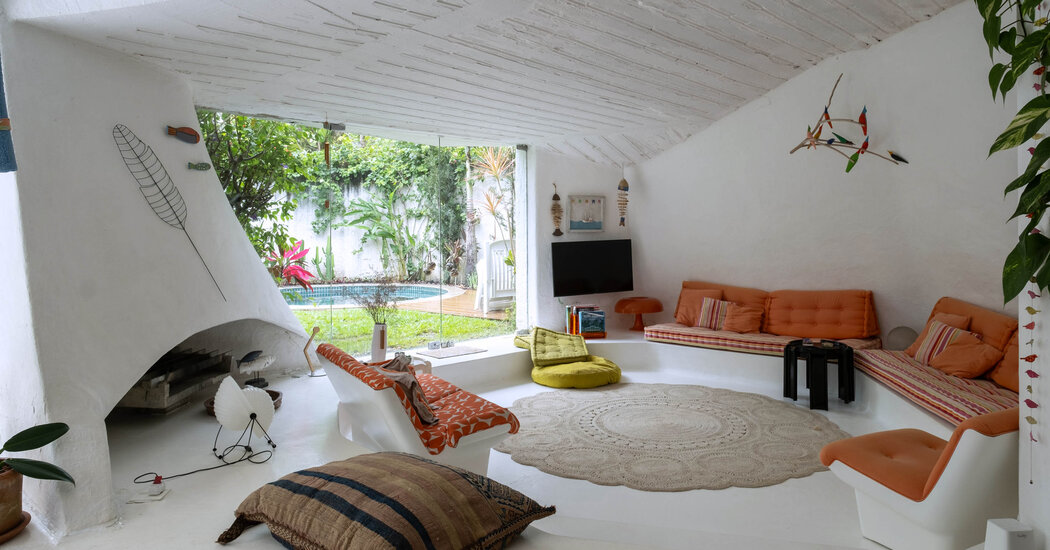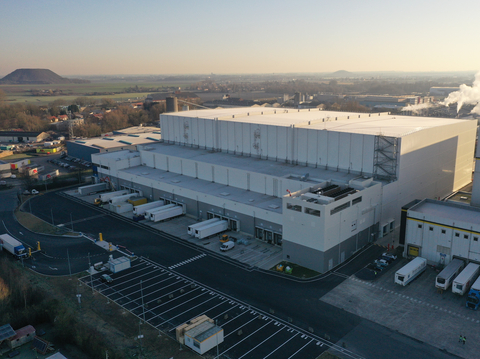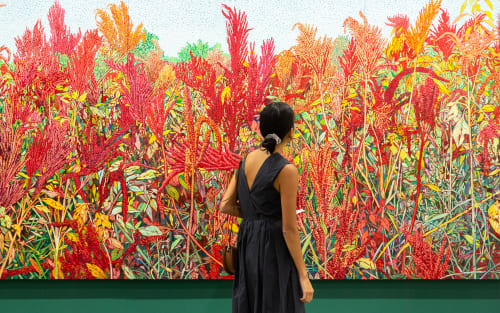THE POLISH BRAZILIAN designer and architect Jorge Zalszupin hated the beach, but he loved the beach house he built in 1972 for his family. Set back from the Atlantic coast in Guarujá, a resort town 40 miles southeast of São Paulo, the 2,842-square-foot white concrete dwelling looks like a block of bleached coral pulled from the ocean. The front door opens onto a spiral staircase that leads to a pair of bedrooms and a lofted lounge; below, the walls of a sunken living room curve up to a sculptural ceiling. A built-in couch wraps around a bell-shaped fireplace, its crescent hearth like an open mouth. Shielded from the Brazilian sun that his wife, a homemaker named Annette, and two daughters adored, Zalszupin would spend entire weekends listening to Chet Baker and Brahms, bent over mounds of clay that he formed into models for chairs and sofas — the furniture that had won him acclaim by the end of the 1950s — and for houses that were, until recently, far less known.
Born in 1922 into a family of middle-class Jews in Warsaw — Jorge was originally Jerzy — Zalszupin narrowly escaped the Nazi invasion of the city, fleeing across the border in 1940 at 18. While many refugees continued onward to Palestine and from there to England, he found shelter with his father and sister in Bucharest, Romania, where he earned his architecture degree, not arriving in Brazil until after the war. “My father always told me that the Guarujá house was a womb,” says Veronica Zalszupin, 69, his older daughter. “Comfort was the whole point. He wanted to feel protected.” Set down among neocolonial cottages, Brutalist bunkers and postwar glass boxes, Zalszupin’s beach house, which is now occupied by his younger daughter, Marina, 66, was the earliest of 10 or so sculptural projects, most of them painted white, that the architect created until the late 1980s. (He retired in 1992.) Together, they represent a joyful, if inadvertent, rejoinder to the Modernist dogmas that have defined Brazilian design for nearly a century: In a country known for the futuristic curves of Oscar Niemeyer and the soaring concrete masses of Paulo Mendes da Rocha, Zalszupin’s houses are clear outliers — organic and earthbound, personal and impossible to replicate.
In many ways, they were outliers for him, too. His furniture had played a clear role in forming Brazil’s midcentury aesthetic, which, with its formal and structural exuberance, expanded Modernism’s hard-edged rationalism. From the establishment of his studio, L’Atelier, in 1959 until his death in 2020 at 98, he helped forge the aspirational tastes of Brazil’s upper middle class, particularly with iconic pieces like the Pétalas coffee table, a blossom of layered and molded rosewood veneer, and the deep-cushioned Presidencial sofa, its cradle of curved wooden slats raised on antennae-slender steel legs. These pieces highlighted Brazil’s natural abundance and the prosperity that might come from harnessing it.
But his so-called Organic Houses — a term applied to the residential projects by curators and academics only within the past few years — emerged from a different paradigm, one that had also begun flourishing in other countries. In the 1920s, as the florid asymmetries of Art Nouveau gave way to the mechanical clarity of the Bauhaus, the Austrian-born American architect, sculptor and stage designer Frederick John Kiesler started developing his ideas of an “endless architecture,” which culminated three decades later in the biomorphic curves of his (ultimately unrealized) Endless House. Around the same time, the Mexican artist and architect Juan O’Gorman, an early proponent of functionalism in the Americas, turned toward an esoteric style exemplified by the midcentury Casa Cueva, with its irregular volumes and elaborate stone mosaics. Each inhabitant of these diverse and divergent buildings would become “a nucleus of natural forces, living in emotions and dreams,” Kiesler writes in a 1949 essay. “Every millimeter of his environment is inspiration.”
Such concepts never gained much traction in São Paulo, according to the 51-year-old architecture professor and curator Guilherme Wisnik. “We’re still essentially Modernists,” he says. “We never accepted pluralism.” But in recent years, young Brazilian designers have begun to question that conviction, taking stock of Modernism’s innovations but also of the traditions and communities that it exoticized and overlooked. As a member of São Paulo’s European intelligentsia, Zalszupin isn’t an obvious figure to draw into such debates, yet he was always defined by dualities: his twin pursuits of ease and restraint, his fascination with industry and love of craft. That’s why some have begun to look anew at his Organic Houses, places where a great Modernist designer made counterarguments against his own methodology. “Zalszupin is an enigma,” Wisnik says. “We’re still searching for him.”
AS THE WAR in Europe ended, Zalszupin moved from Bucharest to Prague to Paris; his first job was working on the reconstruction of the port in Dunkirk, France. Conditions were terrible. “I couldn’t stand the idea of living under the drawing board any longer, of heating my room with an iron stove and firewood pulled from the neighbors’ fences,” he writes in Portuguese in his 2014 autobiography, “De Cu Pra Lua” (which translates literally as “Ass to the Moon,” a Brazilian idiom that refers to inexplicable luck). “I decided I was going to emigrate, and emigrate away from Europe, impoverished by constant wars, content with its past, opposed to any progress since all its glories belonged to history.” While reading the French magazine L’Architecture d’Aujourd’hui, he’d become obsessed with images of Brazil’s then-radical style; he knew where he needed to go next.
In 1949, he arrived in Rio de Janeiro with $500, a suitcase full of French perfume that he planned to sell until he found work and a calling card for Lucjan Korngold, a fellow Polish Jew who’d fled to Brazil during the war and established his own architecture firm in São Paulo. From 1950 to 1958, Zalszupin worked with the older architect on structures largely defined by their hard angles and muscular volumes. He brought those ideas to his own São Paulo-based practice, Prumo, which he ran with José Gugliotta until 1986.
While the buildings from that period are tectonic and strict, his furniture is delicate, dynamic and carefully crafted. In 1970, during the long stretch of economic stagnation following Brazil’s 1964 military coup, Zalszupin sold L’Atelier to the plastics conglomerate Grupo Forsa. There, he became the director of product research and development and designed office furniture and mass-produced kitchenware in colorful polypropylene that found its way into homes and workplaces across the country. “The houses were where he could free his creative impulses,” says Lissa Carmona, the 50-year-old chief executive and curator of Etel, the São Paulo-based design gallery that has held the rights to reproduce Zalszupin’s furniture since 2000. Through the beach house, arguably the first of his organic buildings, Zalszupin discovered “a kind of architecture that was hidden within me and waiting to be released,” he writes in the autobiography.
For his second Guarujá house, built in 1978 for Veronica’s then-in-laws the Leonzinis, Zalszupin became even more conceptual. Where the first house felt close and contained, the five-bedroom, 4,693-square-foot Leonzini House unfurled like a muslin sheet submerged in water, with an undulant terra-cotta tile roof and, inside, meandering hallways paved in rough slabs of slate. The interiors throughout are an eccentric collage: In one bathroom, he had exposed pipes painted black, their playful geometries contrasting against the white walls like a Piet Mondrian painting assembled from Marcel Duchamp readymades.
DESPITE THEIR STRANGENESS, these houses weren’t without precedent in Brazil. The architect and industrial designer Lina Bo Bardi, who emigrated from her native Italy to Brazil three years before Zalszupin, started using curved facades and stone walls around 1960. In the early ’70s, the self-taught designer José Zanine Caldas, who’d grown up in Bahia, began building rustic houses on Rio’s seafront with wooden columns and gabled roofs. Around that time, the São Paulo-based architect Eduardo Longo, now 81, created a series of Mediterranean-style villas in Guarujá, including 1968’s CAL House, next to the lot where Zalszupin would erect the Leonzini House 10 years later. Composed of three oblique pyramids encased in white plaster, the house resembles a fantastical brick kiln. “My peers thought I was ridiculous,” Longo says. “I was more intuitive, and that was frowned upon, [but Zalszupin’s houses] were even more irrational than mine.”
Zalszupin’s urban Organic Houses must have seemed even more shocking. He built the first of these — his favorite, according to Veronica — in 1975 for his friends the art collectors José and Paulina Nemirovsky. Set on a big plot in the wealthy São Paulo neighborhood of Jardim Paulistano, not far from the architect’s own 1962 home, which since 2021 has served as an exhibition space, the Nemirovsky House featured white walls that bent around the vestiges of a tropical landscape mostly destroyed by the city’s breakneck growth. Inside, concrete ceilings bulged into shallow domes imprinted with sunbursts left by meticulous formwork, a tactic he would repeat in one of the last of the Organic Houses, 1989’s Casa Rodriguez in Guarujá.
Zalszupin started construction on his second São Paulo Organic House, a 4,844-square-foot home in the tree-lined residential district of Alto de Pinheiros, in 1975 (the same year he completed work on the Nemirovsky House, which was unceremoniously demolished in 2005). Its current owner, Silvana Cobetta Boni de Souza, a 72-year-old biochemist who purchased the property in 1991, remembers passing the site regularly during its construction and wondering, “ ‘What is this house that doesn’t have a single straight line?’ It was so beautiful, so different.” Its slanted exterior walls snake out onto the sidewalk like the buttress roots of an Amazonian tree rendered in the white plaster of a Baroque church. With its tightly coiled nautilus floor plan, it shares its guarded relationship to the street with more typical Paulista houses of the era, many of them crouched beneath rigid concrete canopies. But its spirit is radically different: It’s not a bunker but a cocoon.
Years before buying her property, Boni had lived in a classic Paulista house, all straight lines and hard concrete, a marvel of rationality that, she says, left much to be desired. “There was no light, no air. It was too hot or too cold, and it was always too dark.” The Zalszupin house is the opposite, its handcrafted walls and labyrinthine hallways imbued with whimsy, its every surface a gesture of gratitude for the country that the architect made his own. “Moving here,” Boni says, “I felt free.”






